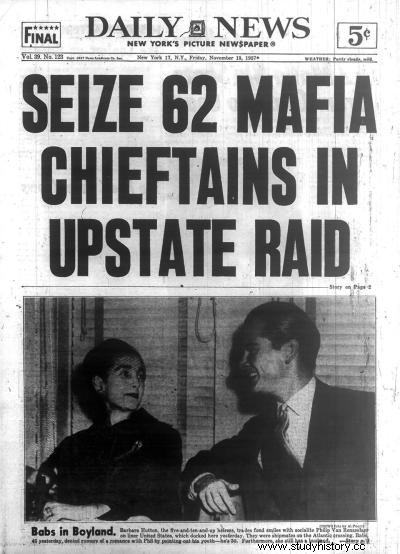After a convulsive period that coincided with the validity of the Volstead Act (better known as Dry Law) in which the American mafia made gold, but in which the streets of Chicago and New York were littered with corpses in the struggle for control of organized crime, the main mafia families of the country met in Chicago in 1931 to discuss the future .
The meeting was called by Charles Lucky Luciano, who had managed to establish himself as the head of the New York mafia after eliminating the capos Joe Massseria and Salvatore Maranzano. Luciano made the rest of the heads of the mafia families see that the street wars and the murders among their members were only detrimental to their business and placed the mafia in the crosshairs of the authorities, especially Hoover's FBI and of the New York prosecutor's office led by Thomas Dewey (see the blog entry dedicated to him).
Luciano's proposal, approved by all the capos , was based on directing the mafia's business as if it were a company, governed by a "board of directors". This council, known as The Commission, It would be made up of the heads of the five main mafia families in the country and it would be up to her to run the business and approve any murder of whoever was considered to be a danger to the organization. A group of especially skilled assassins was even designated to carry out without trace the orders in this sense of The Commission. As if it were a company, this group was known by the name of Murder Inc.
But Luciano found his bones in prison in 1936 as a result of the relentless persecution of prosecutor Dewey. From his prison, Luciano continued to run his family's businesses, with the support of his henchmen Meyer Lanski, Frank Costello, Bugsy Siegel and Vito Genovese, although the latter was forced to flee to Italy to avoid arrest.
During World War II, Luciano's organization, which dominated the docks of New York, helped the authorities to control that sabotage or activities against the country did not take place in the city's port. As compensation Luciano was released after the war on the condition of being deported to Italy. A few years later he moved to Batista's Cuba to direct his business, but a formal protest from the United States, which did not welcome the fact that Luciano was a few miles from Florida, made him have to return again and forever. to Italy; This meant that he had to definitively resign from being the head of the family and directing The Commission.
Frank Costello, whom Luciano had chosen to replace him, resigned after suffering a stroke that nearly cost him his life. Although they had had serious differences in the past and he did not trust him (especially due to his desire for notoriety and his lack of discretion), Luciano had no other choice but to delegate his functions to the head of his criminal group and La Commission in Vito Genovese. Genovese had longed for that position for years and, true to his style, decided to celebrate his desired appointment in a big way.
Genovese summoned all the capos of the main mafia families in the United States to a great party that would take place on November 14, 1957 at the farm owned by mafioso Joe Barbara in Apalachin, a town in the State of New York. The party turned into a massive meeting to which all the capos They came with their luxurious cars and their chauffeur-bodyguards.
Apalachin was a quiet little town west of New York City and close to the Pennsylvania border. When a local police patrol happened to pass by the vicinity of Barbara's farm, they were greatly surprised by the quantity and quality of the vehicles parked there and the people who swarmed around them, all absolutely unusual for that city. They decided to take note of some of the license plates and when they verified them they were even more surprised to find that the vast majority were from out of state and that their owners were known heads of criminal organizations.
Without knowing very well what was happening, they decided to request reinforcements from the state police and proceeded to cordon off the farm. Meanwhile, the guests at Genovese's party, oblivious to what was happening outside, continued to happily celebrate his party. Suddenly the police entered Barbara's house causing confusion and panic among the mobsters who tried to flee in their cars or across fields. However, of the approximately one hundred capos who were present, 58 were arrested, among them great figures of Cosa Nostra such as Genovese himself, Carlo Gambino, Paul Castellano, the host Joseph Barbara or Joe Bonano.
In reality, at least on that occasion, the mobsters were not doing anything illegal and all of them indicated that they had heard that Barbara was very ill and had gone to visit him, for which they were released without charge. Only those who violently objected to arrest were fined $10,000 for obstruction of justice.
However, this funny episode was an ominous way to start the mandate as capo by Vito Genovese. The mafia, which had always sought to go unnoticed and not go public, suddenly saw how it became the cover of all the newspapers in the country. What was a fearful but diffuse and almost mythologized reality for most citizens, suddenly became something perfectly tangible and identifiable with the names of its main members placed black on white in the headlines of newspapers throughout the United States.


It can be said that the Apalachin incident constituted a before and after in the history of the mafia and that there was no more graphic way to capture the transition from the Luciano era to the Genovese era.
